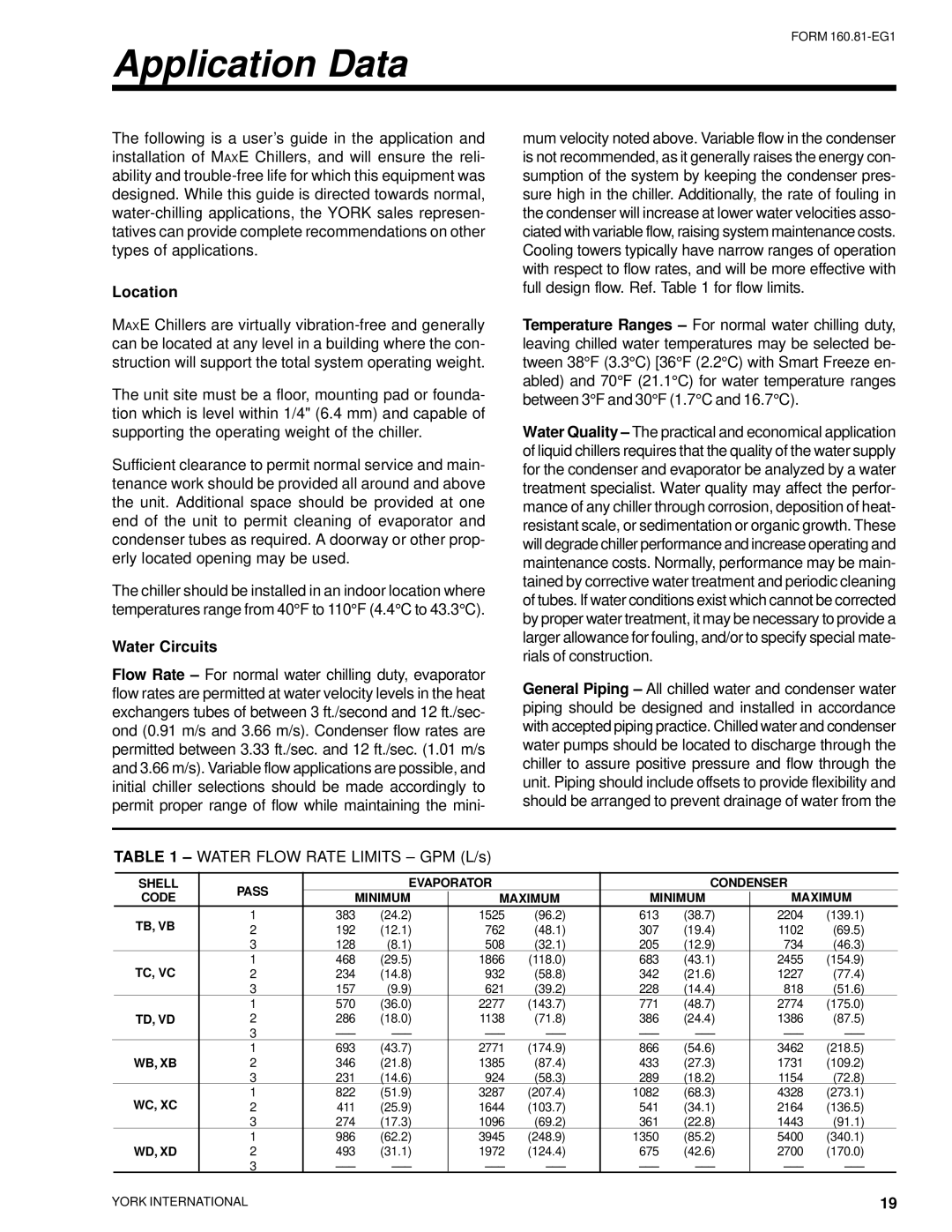
FORM
Application Data
The following is a user’s guide in the application and installation of MAXE Chillers, and will ensure the reli- ability and
Location
MAXE Chillers are virtually
The unit site must be a floor, mounting pad or founda- tion which is level within 1/4" (6.4 mm) and capable of supporting the operating weight of the chiller.
Sufficient clearance to permit normal service and main- tenance work should be provided all around and above the unit. Additional space should be provided at one end of the unit to permit cleaning of evaporator and condenser tubes as required. A doorway or other prop- erly located opening may be used.
The chiller should be installed in an indoor location where temperatures range from 40°F to 110°F (4.4°C to 43.3°C).
Water Circuits
Flow Rate – For normal water chilling duty, evaporator flow rates are permitted at water velocity levels in the heat exchangers tubes of between 3 ft./second and 12 ft./sec- ond (0.91 m/s and 3.66 m/s). Condenser flow rates are permitted between 3.33 ft./sec. and 12 ft./sec. (1.01 m/s and 3.66 m/s). Variable flow applications are possible, and initial chiller selections should be made accordingly to permit proper range of flow while maintaining the mini-
mum velocity noted above. Variable flow in the condenser is not recommended, as it generally raises the energy con- sumption of the system by keeping the condenser pres- sure high in the chiller. Additionally, the rate of fouling in the condenser will increase at lower water velocities asso- ciated with variable flow, raising system maintenance costs. Cooling towers typically have narrow ranges of operation with respect to flow rates, and will be more effective with full design flow. Ref. Table 1 for flow limits.
Temperature Ranges – For normal water chilling duty, leaving chilled water temperatures may be selected be- tween 38°F (3.3°C) [36°F (2.2°C) with Smart Freeze en- abled) and 70°F (21.1°C) for water temperature ranges between 3°F and 30°F (1.7°C and 16.7°C).
Water Quality – The practical and economical application of liquid chillers requires that the quality of the water supply for the condenser and evaporator be analyzed by a water treatment specialist. Water quality may affect the perfor- mance of any chiller through corrosion, deposition of heat- resistant scale, or sedimentation or organic growth. These will degrade chiller performance and increase operating and maintenance costs. Normally, performance may be main- tained by corrective water treatment and periodic cleaning of tubes. If water conditions exist which cannot be corrected by proper water treatment, it may be necessary to provide a larger allowance for fouling, and/or to specify special mate- rials of construction.
General Piping – All chilled water and condenser water piping should be designed and installed in accordance with accepted piping practice. Chilled water and condenser water pumps should be located to discharge through the chiller to assure positive pressure and flow through the unit. Piping should include offsets to provide flexibility and should be arranged to prevent drainage of water from the
TABLE 1 – WATER FLOW RATE LIMITS – GPM (L/s)
| SHELL | PASS |
| EVAPORATOR |
|
| CONDENSER |
|
| ||||
| CODE | MINIMUM |
| MAXIMUM | MINIMUM |
| MAXIMUM | ||||||
|
|
| |||||||||||
|
|
|
| ||||||||||
| TB, VB | 1 | 383 | (24.2) |
| 1525 | (96.2) | 613 | (38.7) |
| 2204 | (139.1) |
|
| 2 | 192 | (12.1) |
| 762 | (48.1) | 307 | (19.4) |
| 1102 | (69.5) |
| |
|
| 3 | 128 | (8.1) |
| 508 | (32.1) | 205 | (12.9) |
| 734 | (46.3) |
|
| TC, VC | 1 | 468 | (29.5) |
| 1866 | (118.0) | 683 | (43.1) |
| 2455 | (154.9) |
|
| 2 | 234 | (14.8) |
| 932 | (58.8) | 342 | (21.6) |
| 1227 | (77.4) |
| |
|
| 3 | 157 | (9.9) |
| 621 | (39.2) | 228 | (14.4) |
| 818 | (51.6) |
|
|
| 1 | 570 | (36.0) |
| 2277 | (143.7) | 771 | (48.7) |
| 2774 | (175.0) |
|
| TD, VD | 2 | 286 | (18.0) |
| 1138 | (71.8) | 386 | (24.4) |
| 1386 | (87.5) |
|
|
| 3 |
|
| |||||||||
| WB, XB | 1 | 693 | (43.7) |
| 2771 | (174.9) | 866 | (54.6) |
| 3462 | (218.5) |
|
| 2 | 346 | (21.8) |
| 1385 | (87.4) | 433 | (27.3) |
| 1731 | (109.2) |
| |
|
| 3 | 231 | (14.6) |
| 924 | (58.3) | 289 | (18.2) |
| 1154 | (72.8) |
|
| WC, XC | 1 | 822 | (51.9) |
| 3287 | (207.4) | 1082 | (68.3) |
| 4328 | (273.1) |
|
| 2 | 411 | (25.9) |
| 1644 | (103.7) | 541 | (34.1) |
| 2164 | (136.5) |
| |
|
| 3 | 274 | (17.3) |
| 1096 | (69.2) | 361 | (22.8) |
| 1443 | (91.1) |
|
| WD, XD | 1 | 986 | (62.2) |
| 3945 | (248.9) | 1350 | (85.2) |
| 5400 | (340.1) |
|
| 2 | 493 | (31.1) |
| 1972 | (124.4) | 675 | (42.6) |
| 2700 | (170.0) |
| |
|
| 3 |
|
| |||||||||
YORK INTERNATIONAL | 19 |
